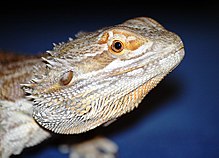Pogona: Difference between revisions
copy edit, commented out care instructions |
No edit summary |
||
| Line 39: | Line 39: | ||
===Diet=== |
===Diet=== |
||
Bearded Dragon crunch on leaves and live crickets. |
|||
[[File:BeardedDragonEatting.jpg|thumbnail|Bearded dragon eating [[dandelion]] leaves]] |
|||
Bearded dragons are native to the central Australian desert, where food is often scarce. They are [[omnivore|omnivorous]], capable of subsisting on a wide variety of food sources. In the wild, they will eat just about anything they can catch.[http://nationalzoo.si.edu/Animals/ReptilesAmphibians/Facts/FactSheets/Inlandbeardeddragon.cfm] |
Bearded dragons are native to the central Australian desert, where food is often scarce. They are [[omnivore|omnivorous]], capable of subsisting on a wide variety of food sources. In the wild, they will eat just about anything they can catch.[http://nationalzoo.si.edu/Animals/ReptilesAmphibians/Facts/FactSheets/Inlandbeardeddragon.cfm] |
||
Revision as of 00:14, 23 January 2013
| Pogona | |
|---|---|

| |
| Pogona vitticeps | |

| |
| P. vitticeps - detail of head | |
| Scientific classification | |
| Domain: | |
| Kingdom: | |
| Phylum: | |
| Class: | |
| Order: | |
| Suborder: | |
| Family: | |
| Subfamily: | |
| Genus: | Pogona
|
| Species | |
|
Pogona barbata | |
Pogona is a genus of lizards containing seven species, which are often known by the common name bearded dragons. The term "bearded dragon" is most commonly used to describe the central bearded dragon. Members of this genus live in the arid, rocky, semidesert regions and dry open woodlands of Australia. They are adept climbers, spending time on branches and in bushes and near human habitation. Pogona species bask on rocks and exposed branches in the mornings and afternoons. The species are found throughout Australia.[1]
Several species of this genus, especially Pogona vitticeps, are often kept as pets or exhibited in zoos.
Description
This section needs expansion. You can help by adding to it. (January 2011) |
The genus is in the subfamily Agaminae of the family Agamidae. Their characteristics include spiny scales arranged in rows and clusters. These are found on the throat, which can be expanded when threatened, and at the back of the head. These spiny scales are used to scare off predators, yet they are not very sharp. The species also displays a hand-waving gesture; this is to show submission between dragons. They also have a head-bobbing act to show dominance. They have the ability to change colour during rivalry challenges between males, and in response to temperature changes and other stimuli, such as turning black to absorb heat. They can grow to the size of about 12 to 18 in (300 to 460 mm).[1]
In captivity
Bearded dragons, agamid lizards of the genus Pogona, are often kept as pets, most commonly Pogona vitticeps, the inland or central bearded dragon. Pogona describes seven species naturally found in arid or semiarid woodlands and rocky deserts in central Australia.
They are a popular species among children, because of their friendly and calm nature, along with the relative ease of caring for them.[2] Bearded dragons have broad, triangular heads and flattened bodies, with adults reaching about 16 to 24 in (410 to 610 mm) from head to tail and weighing 350 to 600 g (10 to 20 oz).[3]
Diet
Bearded Dragon crunch on leaves and live crickets.
Bearded dragons are native to the central Australian desert, where food is often scarce. They are omnivorous, capable of subsisting on a wide variety of food sources. In the wild, they will eat just about anything they can catch.[1]
A typical captive bearded dragon's diet consists mostly of leafy greens, vegetables and noncitrus fruits, supplemented regularly with insects. Crickets are the most popular feeder choice, but bearded dragons can also be fed other insects such as black soldier fly larvae, locusts, superworms, waxworms, silkworms, butterworms, grasshoppers, and even certain varieties of roaches.[2] Young dragons require a significantly greater insect-to-plant matter ratio in their diets than adults.[4]
External links
References
- ^ a b Browne-Cooper, Robert (2007). Reptiles and Frogs in the Bush: Southwestern Australia. University of Western Australia Press. p. 160. ISBN 978-1-920694-74-6.
Pogona minor minor, Abrolhos Bearded Dragon
{{cite book}}: Cite has empty unknown parameters:|month=and|chapterurl=(help); Unknown parameter|coauthors=ignored (|author=suggested) (help) - ^ a b Jaeger, Jeremiah. "Bearded Dragons Care Sheet". beardeddragon.org. Retrieved 11 September 2012.
- ^ "Hades Dragons". hadesdragons.co.uk. Retrieved 11 September 2012.
- ^ Daichu, Robert and Victoria (26 May 2007). "Frequently Asked Questions". Retrieved 11 September 2012.
